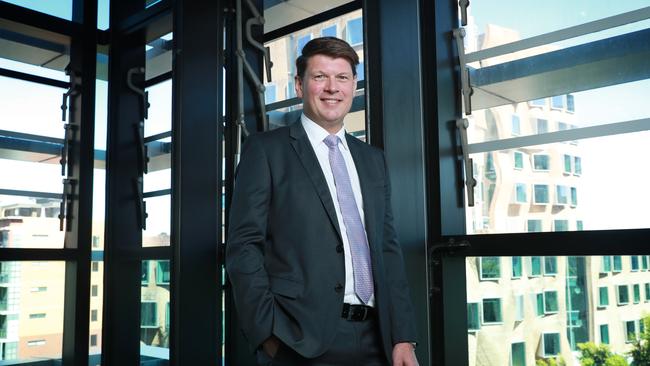2030 targets on course to be missed by year or two, Transgrid head and former AGL CEO says
Renewable energy will generate 82 per cent of Australia’s power by 2031 or 2032 which is a year or two later than targeted, Transgrid chief Brett Redman says.
Renewable energy will generate 82 per cent of Australia’s power by 2031 or 2032 – a year or two later than targeted, Transgrid chief Brett Redman forecasts.
While he praised the federal government’s move to hasten Australia’s transition away from coal, he cautioned that recent delays to major projects probably meant the country would miss its 2030 target.
“2030, I do think, is looking very challenging with the delays that we have seen to date. Now that doesn’t mean that you fall into the pit of despair. You talk about maybe a year or so of slippage rather than a cliff edge,” Mr Redman told a conference in Sydney on Friday.
Doug Moss, managing director for UGL, a contractor building major energy projects such as Snowy Hydro Kurri Kurri gas facility, said the targets would be extremely challenging but meeting them would be a boon for developers such as his company. “From a sort of contractor’s point of view, there is going to be plenty of work,” Mr Moss said. “2030 is hard, no doubt, but I think it is a bit of a sort of beachhead – sort of something to aim for and 2050 certainly achievable.”
A failure to hit the target would be a blow to Labor, which has insisted it will oversee the transition by 2030 despite widespread scepticism. However, Mr Redman said that would not be disastrous and could still represent a significant achievement.
While coal’s contribution to energy supply is waning quickly, Australia is struggling to develop sufficient quantities of renewable energy.
The perceived difficulty of Australia reaching its 2030 transition targets has been seized on by the Coalition as justifying its plan to build seven nuclear power stations. But Mr Redman, a former chief executive of AGL Energy, reaffirmed his comments that he did not believe nuclear was a viable alternative.
James Hunt, the vice president of power systems and services at Schneider Electric, said the Coalition’s alternative energy policy had created an ideological divide that threatened to prolong the transition.
“There are challenges in getting there by 2030 but we can achieve it as long as we don’t get bogged down in ideological debates around one technology over another,” he said.
The Australian Energy Market Operator estimates the country needs 57GW of grid-scale solar and wind generation capacity to be installed by 2030 – a rise from the current capacity of 19GW.
A plethora of problems are slowing the rollout of Australia’s renewable energy projects, according to industry players, including planning holdups, community opposition, transmission delays and concerns about how the grid will be powered when the sun is not shining or the wind is not blowing.
States have different planning rules, and some jurisdictions have more developer-friendly measures that limit the capacity of opponents to block new wind and solar developments.
The Victorian Labor government earlier this year said it would accelerate planning approvals for renewable energy projects worth $90bn, while the avenues of appeal would be limited – a move condemned by some rural communities.
NSW is updating its planning guidelines with rules about wind developments expected to be announced imminently.

Developers have urged the NSW government to remove the right of some landowners to propose future dwellings on their land – which could require renewable energy companies to remove large swathes of wind turbines and makes projects unviable.
The construction of transmission lines is also proving frustratingly slow as transmission companies grapple with pockets of opposition.
State governments have moved to unlock the bottleneck by increasing offers of financial compensation – though some communities have vowed to oppose the developments.
While energy industry officials have expressed confidence that these issues will be resolved, there remains significant uncertainty about what will underpin the rise of wind and solar power.
Australia’s east coast earlier this year suffered a so-called wind drought which led to electricity prices spiking. To compensate for the loss of wind power, Australia was increasingly reliant on gas.
But Australia’s east coast faces a shortage as soon as 2026.
The energy industry has warned that batteries will be insufficient to compensate as they typically only have a duration of between two and four hours.
Gas appears to be the most realistic option until the completion of Snowy Hydro 2.0, which will have sufficient capacity to underpin renewables. It is expected to be operational from 2027.
However, the demonisation of gas has seen new developments opposed – though Mr Redman said he believed attitudes towards the fuel source were changing.
“The feeling around gas has shifted in the last few years,” Mr Redman said.
“I can see a future where gas is establishing its case as the backup fuel of the system. The back-up fuel historically was diesel.”
Gas is used primarily as a “peaker”. Gas power stations can be fired up and shut down in minutes, but opponents insist using gas will slow the transition to renewables.
Proponents insist that using gas will allow Australia to shut more coal power stations, some of which have had their lifetimes extended amid concerns about the capacity of the grid to deal with their retirement.







To join the conversation, please log in. Don't have an account? Register
Join the conversation, you are commenting as Logout